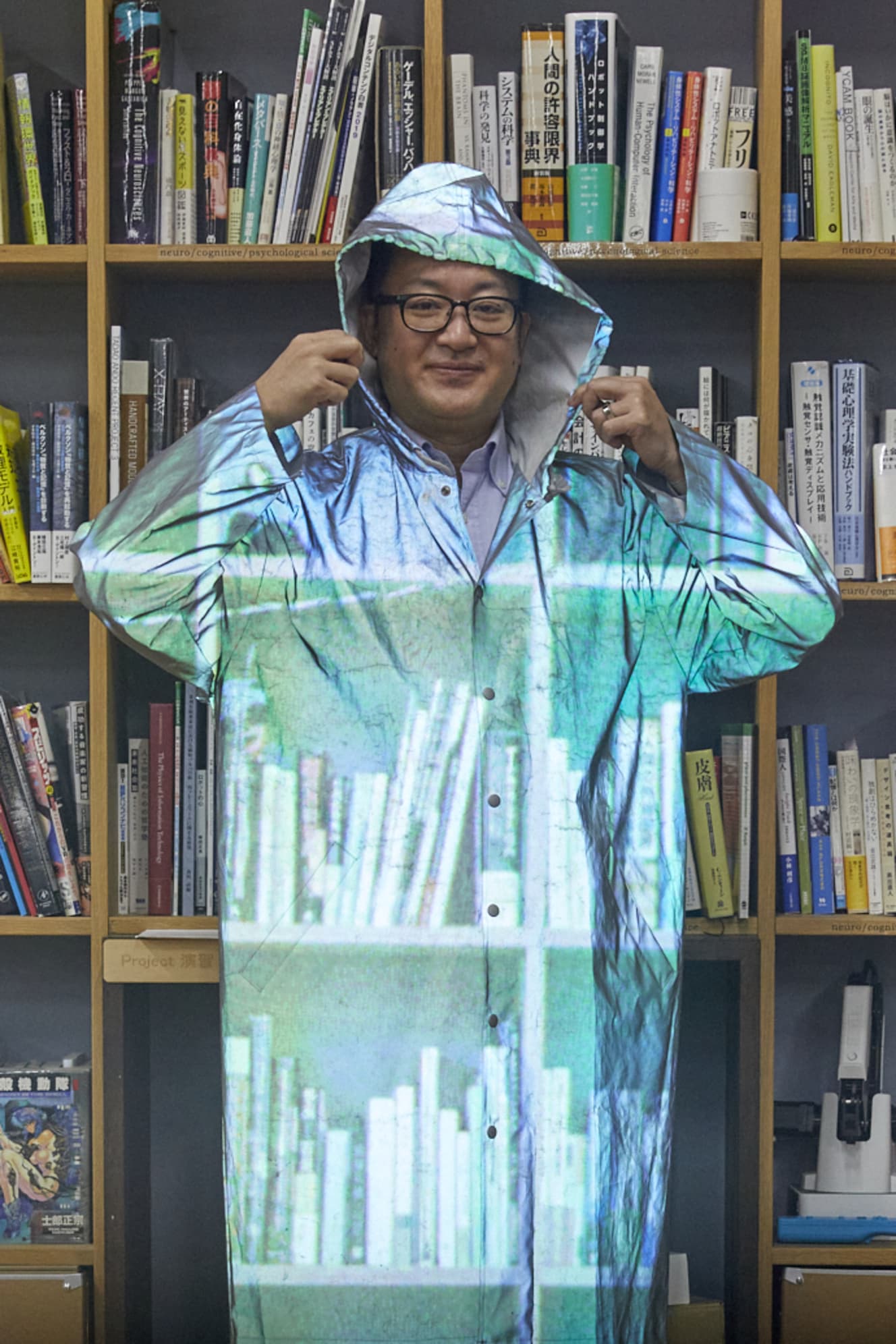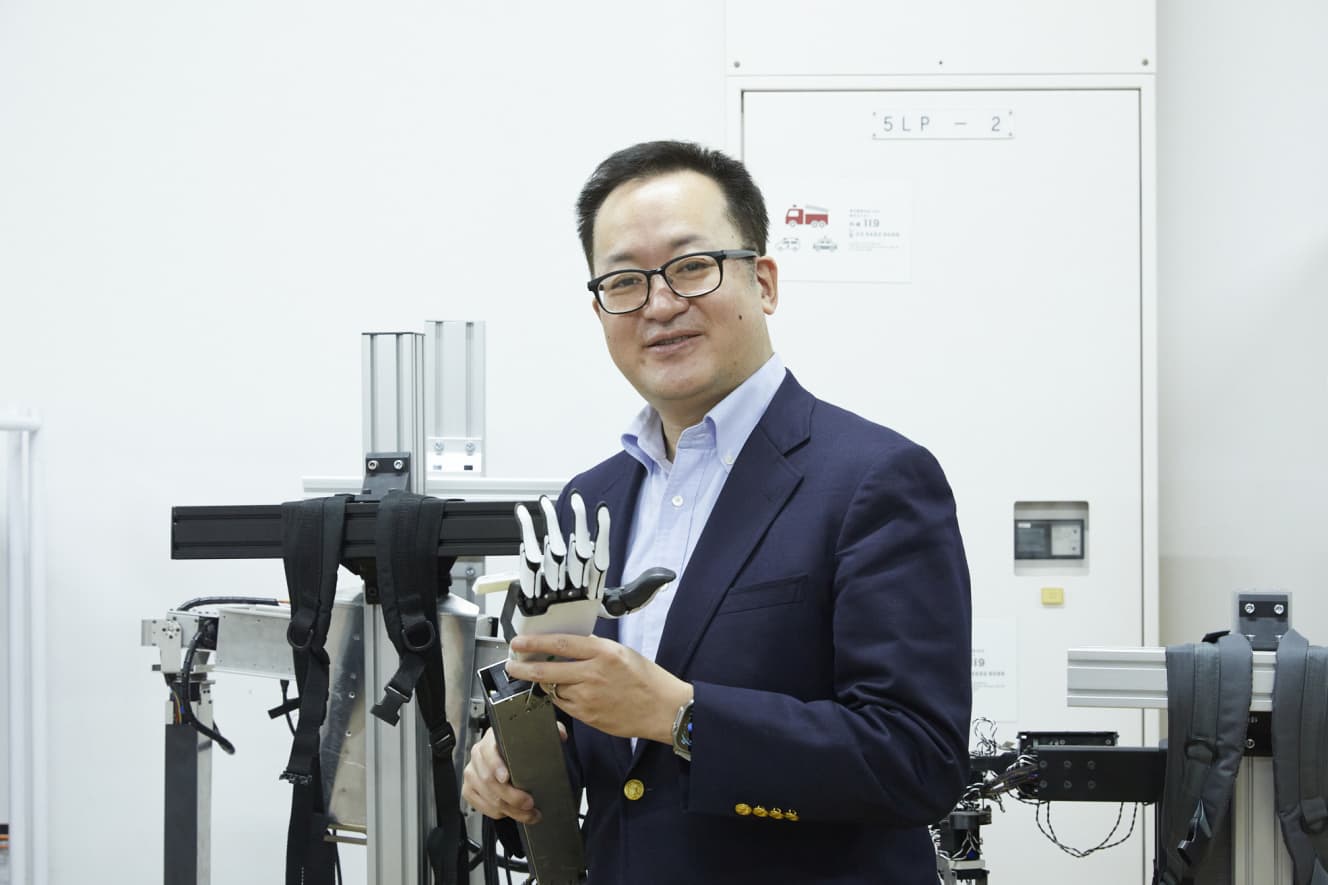The University of Tokyo professor who invented the “To-mei Mantle” creates the “next secret tool
The “Tomei Mantle” developed 25 years ago!
The “Tomei Cloak” from “Doraemon” is a cloak that turns invisible when worn over the head. It was actually created by Professor Masahiko Inami of the University of Tokyo’s Research Center for Advanced Science and Technology.
When I was in junior high school, I saw a person flying over the stadium at the opening ceremony of the Los Angeles Olympics carrying a rocket-like device on his back, and I wanted to create something like Doraemon’s secret tool. I thought that by cloaking myself in technology, I might be able to do something that ordinary people cannot do.
Professor Inami created the “Tomei Cloak” 25 years ago. The cloak is made of a retroreflective material that does not scatter incoming light, but instead returns it in a straight line. This material is also used in traffic signs, etc. When the same image as the background is projected using this property, it appears as if the person in the cape has become transparent.
Professor Inami’s laboratory has so far developed various “Inami’s version of secret tools,” such as “JINS MEME,” glasses that measure eye potential (developed jointly with JINS), and “Kendama Dekade! VR” (jointly developed with Imacreate), which enables users to learn Kendama quickly.
When a student wears the “JINS MEME,” the eye potentials can tell whether the student is getting bored with the lecture or whether he/she is writing down the answers to the test with a good understanding of the material. VR” is a VR practice kendama game in which users learn basic movements in slow motion at first, then gradually increase the speed back to normal to master the technique. The company has applied this technology to develop software that enables accurate muscle injections, which was used in training for injecting vaccines for the COVID-19 crisis.

We want to make it possible to do things that no one in the world can do.
Research to enable people to do things that ordinary people cannot do. …… “Human augmentation engineering” is Professor Inami’s specialty. Prosthetics” is the term used to describe the process of replacing lost functions of the body, such as giving a limp to a person with a disability, and research into this process has been ongoing for many years.
Prosthetics is about how to bring a negative situation back to “zero. My goal is to turn a negative situation into a positive one, or a zero into a positive one.
I feel great joy when I can do something that I could not do before. For example, I have always been bad at sports, but with the help of technology, I may be able to play an active role in sports. If that happens, I will be happy.
As we get older, there are more and more things we cannot do, but if we can do them, we can have more hope for the future. That is what I hope to achieve.”
In 2013, Professor Inami established the “Chojin Sports Association” to promote “Chojin Sports,” not only in theory, but also to encourage people to experience the joy of being able to do what they cannot do. The “Bubble Jumper,” in which participants wear Western stilts made of springs on their legs and a transparent, elastic sphere on their upper body, and fight against opponents, and the “Rock Hand,” in which participants wear arms resembling rocks and clash with opponents.
At the esports park “RED TOKYO TOWER,” which opened in Tokyo Tower Foot Town, visitors can enjoy several kinds of superhuman sports.


Spreading the “Third and Fourth Arms” Around the World
Another goal of Professor Inami’s is to develop a “human-machine at-one-glance” system in which a machine assists the user in doing what he or she wants to do, when he or she wants to do it, just as if the user were his or her own body. While robots working in factories or machines taking the place of humans is “automation,” Professor Inami is aiming for a system in which machines will assist people when they want to do things, just as if they were their own bodies.
For example, when typing on a PC, “Kanji conversion” and “Predictive Conversion” assist the user’s ability to write and compose sentences quickly. In this way, AI and robots extend human capabilities. I call it ‘Jinki-Itai,’ not ‘automation,’ but ‘Jizuka-ka.
Professor Inami is currently focusing on “third and fourth arms” and “flexible limbs,” which are designed to be used with two or four robot arms, but we have only two arms to begin with, and we don’t know how to move more than two arms.
Fusion” is a robot arm that can be remotely controlled by another human being, so that the wearer and the operator “merge” and work together, like a “two-person weave.
The “Jizai Limb,” which applies this concept, is a work that expands the possibilities of expression by stimulating the imagination and inducing movements that have never been seen before. We have already performed this work with dancers, and we hope to spread it around the world.
If this robot arm can move freely, it could be used for sports training and rehabilitation by guiding one’s arm, just as a calligraphy teacher can teach you how to write with your hand, and if dancers try dancing with the free arm, they will be drawn in like a jazz band, naturally becoming one with the human body. Dancers may be drawn into dancing with the free limbs, becoming one with nature and mankind, and a new world may open up. How will our lives change?
Courtesy of Inami/Kadouchi Laboratory & KEIO MEDIA DESIGN, The University of Tokyo
Courtesy of: JST ERATO Inami Free Bodies Project, Inami/Kadoouchi Laboratory, Department of Body Informatics, Research Center for Advanced Science and Technology, The University of Tokyo, and Yamanaka Toshiharu Laboratory, Mechanical and Biological Systems Division, Institute of Industrial Science, The University of Tokyo.
I still get inspiration from “Doraemon
Even now, I sometimes read “Doraemon” again and again. It is a great simulation of how people’s lives and movements will change when new technologies are introduced. I read it while thinking, ‘Is this direction possible?
Although not developed by the professor, there are many secret tools of Doraemon that are becoming a reality. Joby Aviation, an American small aircraft manufacturer, has applied to the Ministry of Land, Infrastructure, Transport, and Tourism for a “type certificate” for a “flying car,” though not quite a bamboo-copter, and aims to begin operating it in the Kansai region starting with the Osaka-Kansai Expo in 2025.
The terraigistics that make the robot appear to be in a place other than its actual location or make it feel as if it exists is similar to the “Door to Anywhere”. You can go anywhere in the world as if you were a robot.
Doraemon’s secret tool is called “Small Light,” which becomes smaller when illuminated, and with the use of VR goggles, we can now have an experience similar to that. I think that Doraemon’s secret tools will continue to be realized in the future.
I still want to fly. Now we can ride on a drone, but it seems to be difficult to control, doesn’t it? Takecopters can fly so freely that you don’t even know how you’re controlling it. It is truly a human-machine as one. I would like to build something like that.
Masahiko Inami is a professor in the Department of Body Informatics, Research Center for Advanced Science and Technology, and Special Assistant to the President at the University of Tokyo. When he was a student at Tokyo Institute of Technology, he was a member of the Tokyo Tech Robot Technology Research Group, a student club, and built many virtual reality systems as a hobby. He was a research associate at the University of Tokyo, a visiting researcher at the Massachusetts Institute of Technology’s Computer Science and Artificial Intelligence Laboratory, a professor at the University of Electro-Communications’ Department of Intelligent Mechanical Engineering, and a professor at Keio University’s Graduate School of Media Design before assuming his current position. In 2003, he was selected as one of the Coolest Inventions 2003 by TIME magazine.
Interview and text by: Izumi Nakagawa Photographed by: Mutsuko Kudo